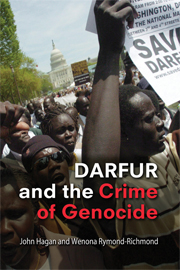Book contents
- Frontmatter
- Contents
- Glossary
- List of Characters
- Prologue: On Our Watch
- Darfur and the Crime of Genocide
- Settlement Cluster Map of Darfur, Sudan
- 1 Darfur Crime Scenes
- 2 The Crime of Crimes
- 3 While Criminology Slept with Heather Schoenfeld
- 4 Flip-Flopping on Darfur with Alberto Palloni and Patricia Parker
- 5 Eyewitnessing Genocide
- 6 The Rolling Genocide
- 7 The Racial Spark
- 8 Global Shadows
- Epilogue: Collective R2P
- Appendix: Genocidal Statistics
- Notes
- Index
- Titles in the series
4 - Flip-Flopping on Darfur with Alberto Palloni and Patricia Parker
Published online by Cambridge University Press: 05 June 2012
- Frontmatter
- Contents
- Glossary
- List of Characters
- Prologue: On Our Watch
- Darfur and the Crime of Genocide
- Settlement Cluster Map of Darfur, Sudan
- 1 Darfur Crime Scenes
- 2 The Crime of Crimes
- 3 While Criminology Slept with Heather Schoenfeld
- 4 Flip-Flopping on Darfur with Alberto Palloni and Patricia Parker
- 5 Eyewitnessing Genocide
- 6 The Rolling Genocide
- 7 The Racial Spark
- 8 Global Shadows
- Epilogue: Collective R2P
- Appendix: Genocidal Statistics
- Notes
- Index
- Titles in the series
Summary
It's [the low mortality estimate] a deliberate effort by the Bush Administration to downplay the severity of the crisis in order to reduce the urgency of an additional response. I find that to be disingenuous and perhaps murderous.
– John Prendergast, International Crisis Group April 26, 2005The Atrocities Documentation Survey
Documenting Atrocities in Darfur is the title of the eight-page report based on a survey of Darfur refugees in Chad and published by the U.S. Department of State in September 2004. The report's chillingly cogent tables, charts, maps, and pictures – derived from interviews with 1,136 refugees in Chad – speak volumes. Our recording from the Atrocities Documentation Survey (ADS) identified more than 12,000 deaths and many more rapes and atrocities that the respondents personally witnessed or heard about before fleeing. The report opens with a chart listing these statistics:
81 percent reported their village was destroyed.
80 percent reported their livestock was stolen.
67 percent reported witnessing or experiencing aerial bombing.
61 percent reported the killing of a family member.
44 percent reported witnessing or experiencing a shooting.
33 percent reported hearing racial epithets during attacks.
Secretary of State Colin Powell made headlines when he presented these findings to the UN Security Council and the U.S. Congress as evidence of Sudanese-sponsored genocide in Darfur.
- Type
- Chapter
- Information
- Darfur and the Crime of Genocide , pp. 79 - 104Publisher: Cambridge University PressPrint publication year: 2008

